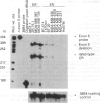Abstract
Wild-type as well as variant oestrogen receptor (ER) mRNAs with exon 5 and 7 deleted were identified in a panel of human breast tumour cell lines by reverse transcriptase-polymerase chain reaction followed by dideoxynucleotide sequence analysis, and then quantitated by ribonuclease protection analysis. All cell lines categorised as ER+ by ligand-binding analysis expressed both wild-type and variant ER transcripts. Most cell lines classified as ER- did not express any ER transcript. However, three ER- cell lines (BT-20, MDA-MB-330 and T47Dco) expressed both wild-type and variant transcripts. A differential pattern of expression of wild type to variant was seen in both ER+ and ER- cell lines, however this pattern was not paralleled by differences in ligand-binding activity. Breast tumour cell lines previously classified as ER- expressed significantly lower levels of ER transcripts than did their ER+ counterparts. In view of these findings, as well as earlier reports that the exon 5 deletion ER variant encodes a dominant-positive receptor, it seems clear that some cell lines are misclassified as ER-, and express both wild-type and variant ER mRNAs, and that the overexpression of this variant may account, in part, for their oestrogen-independent phenotype.
Full text
PDF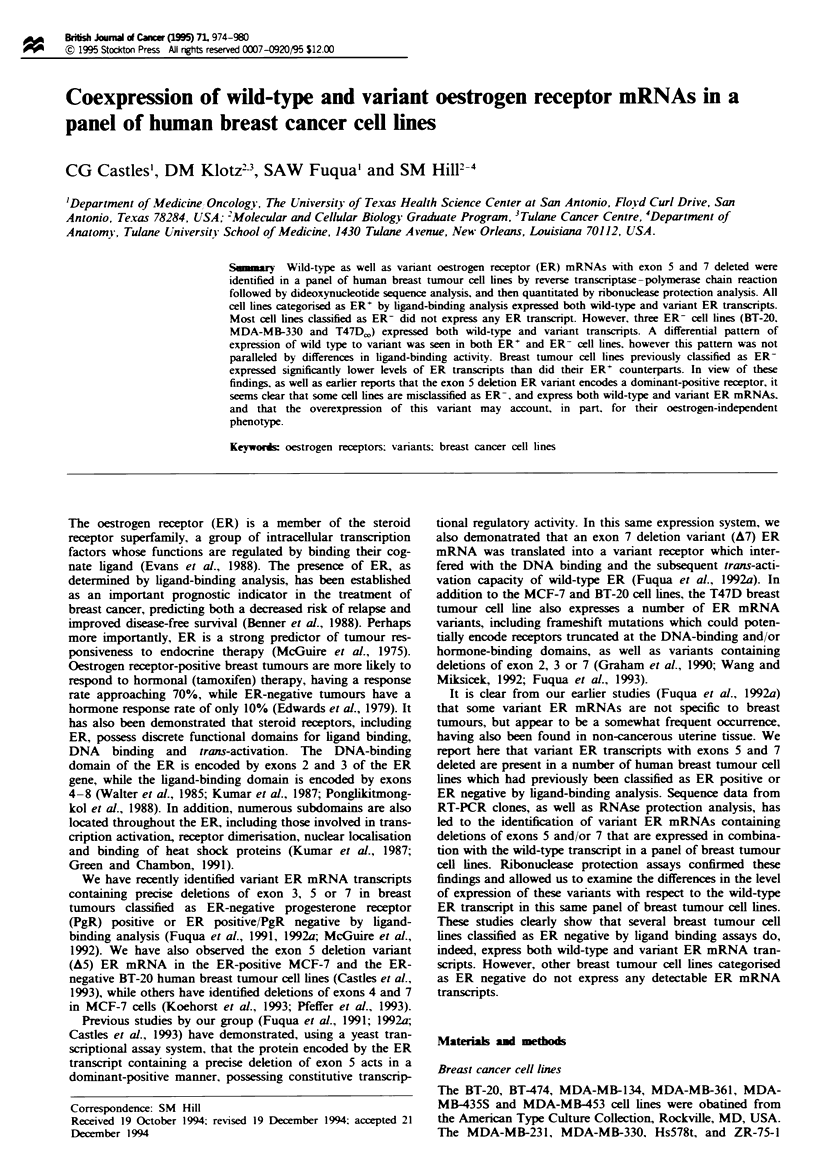
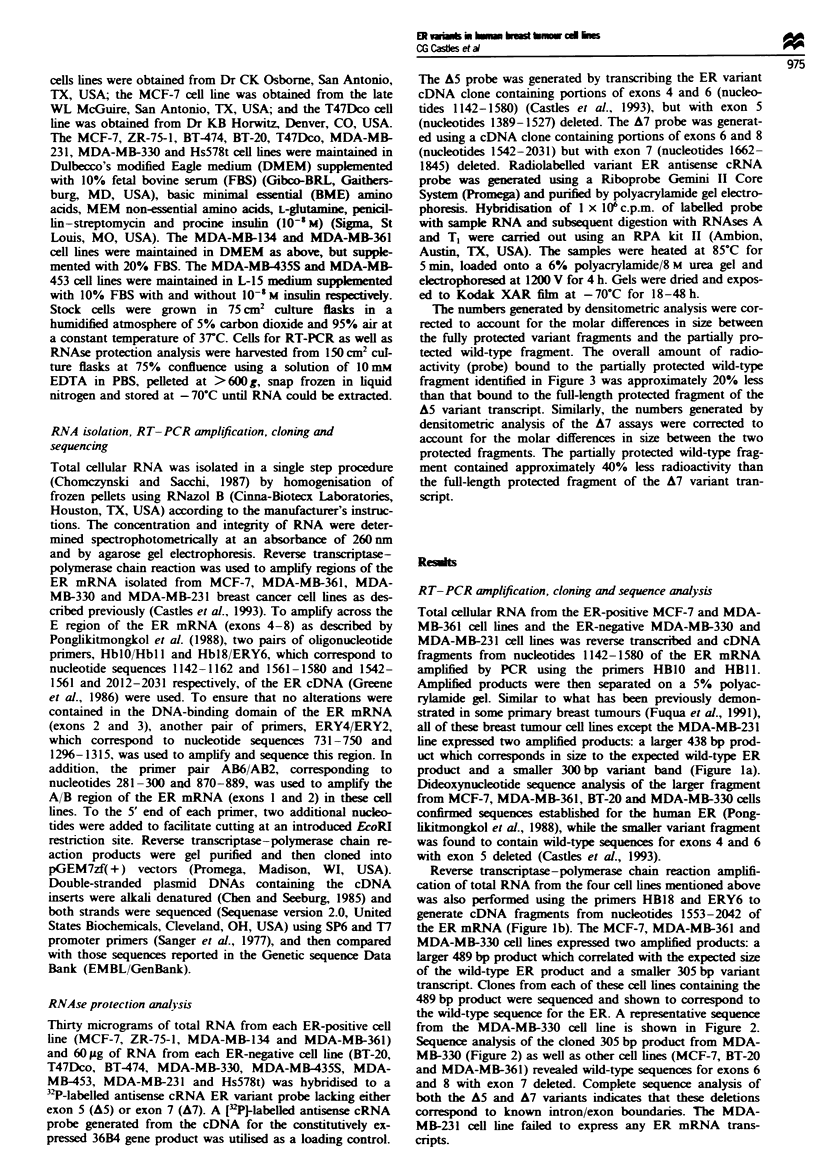
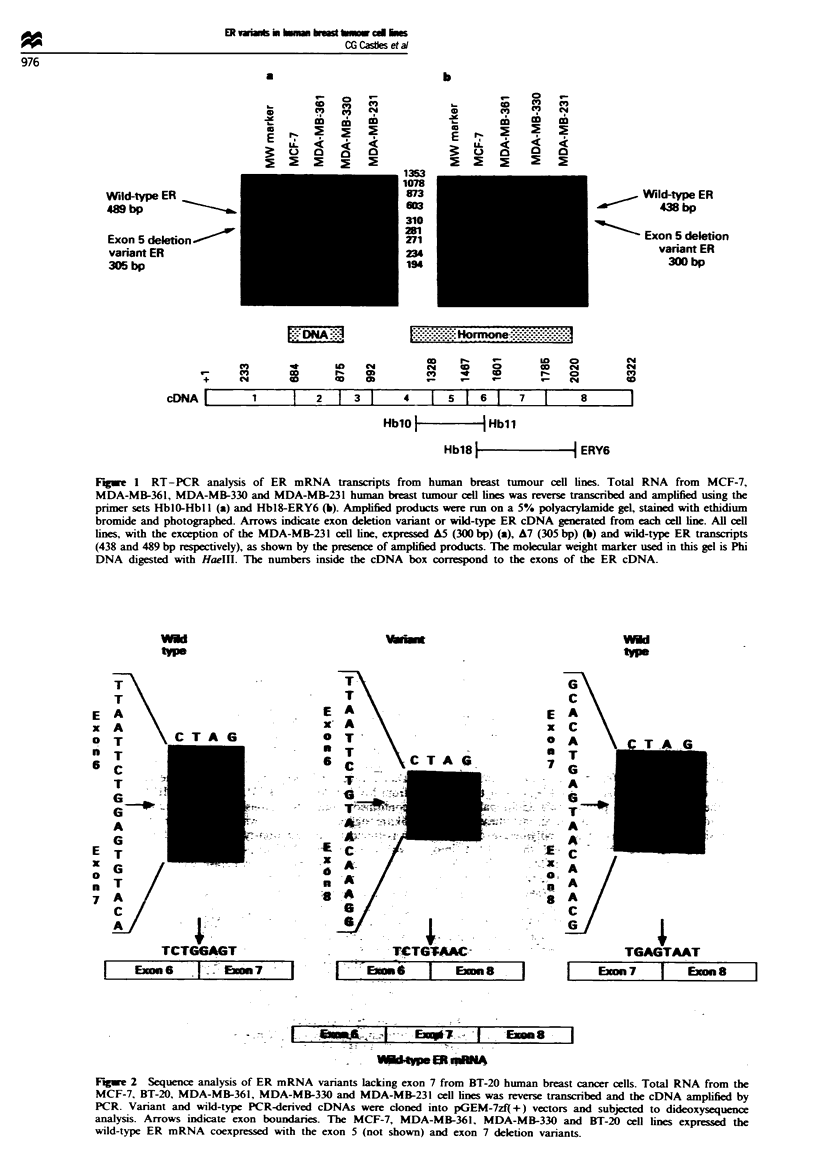
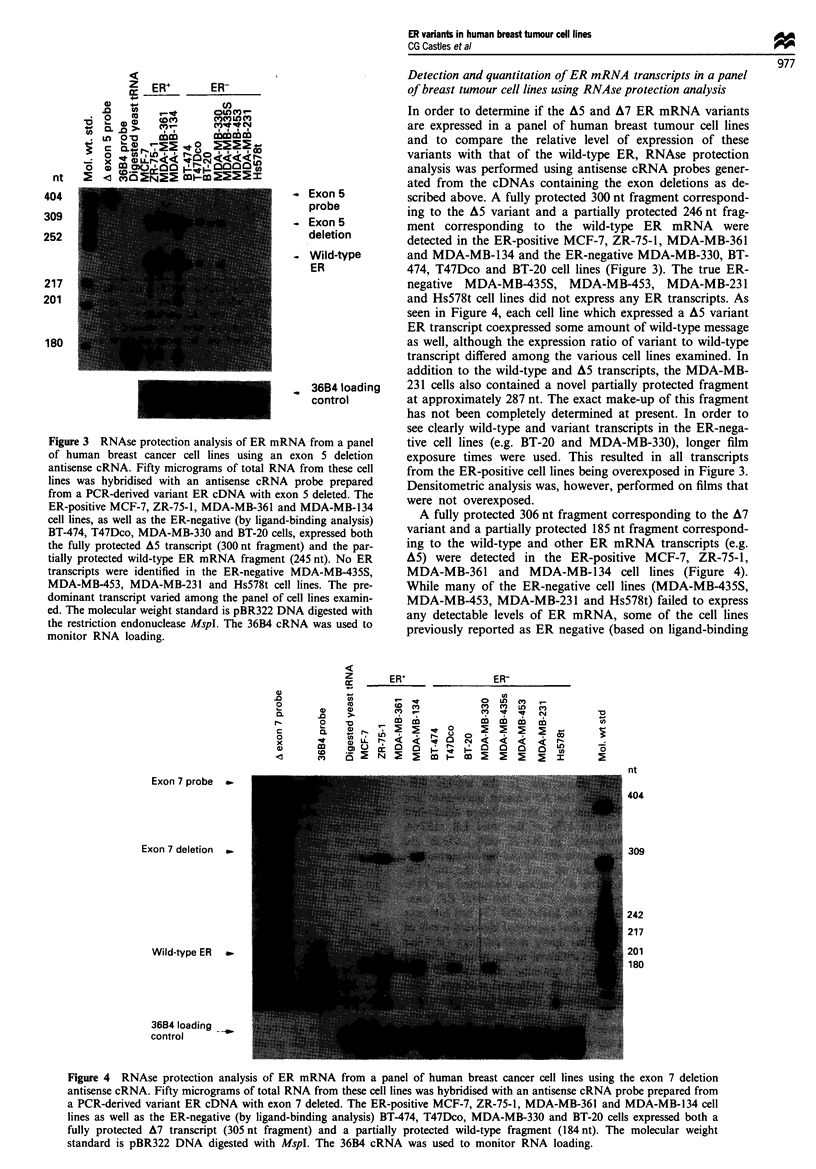
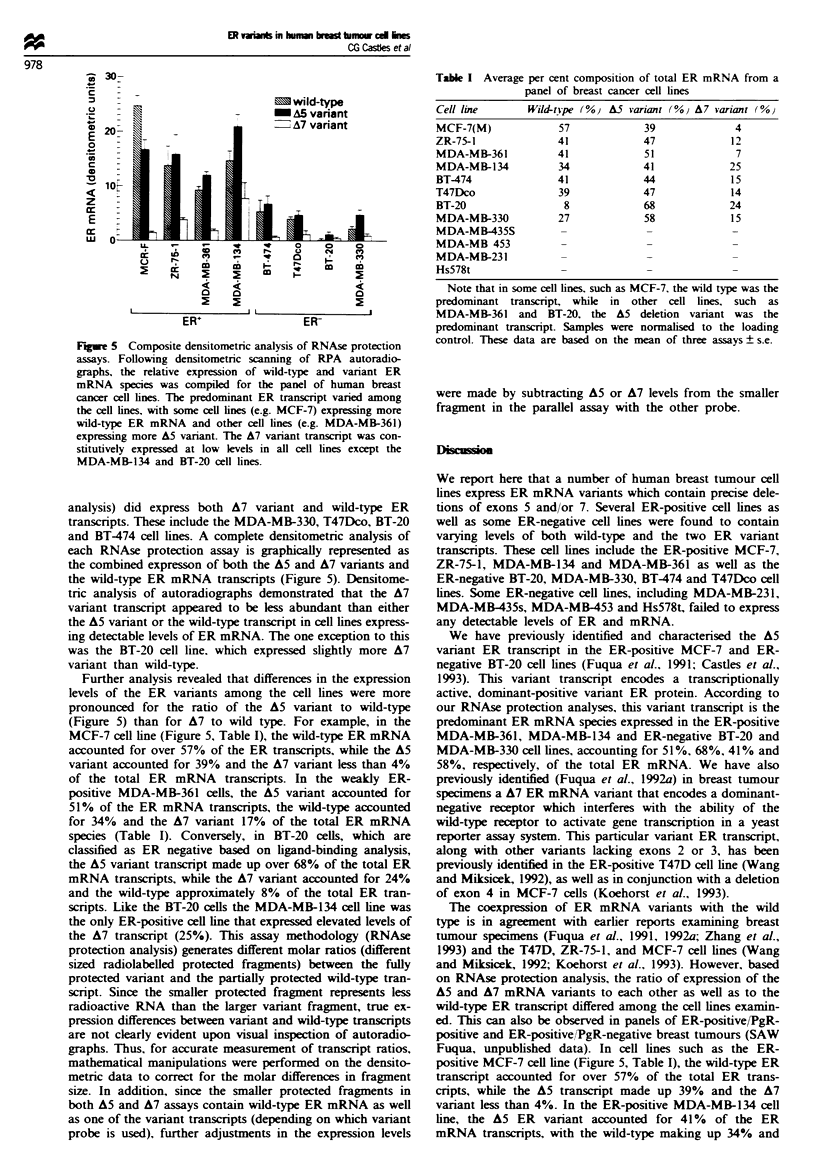
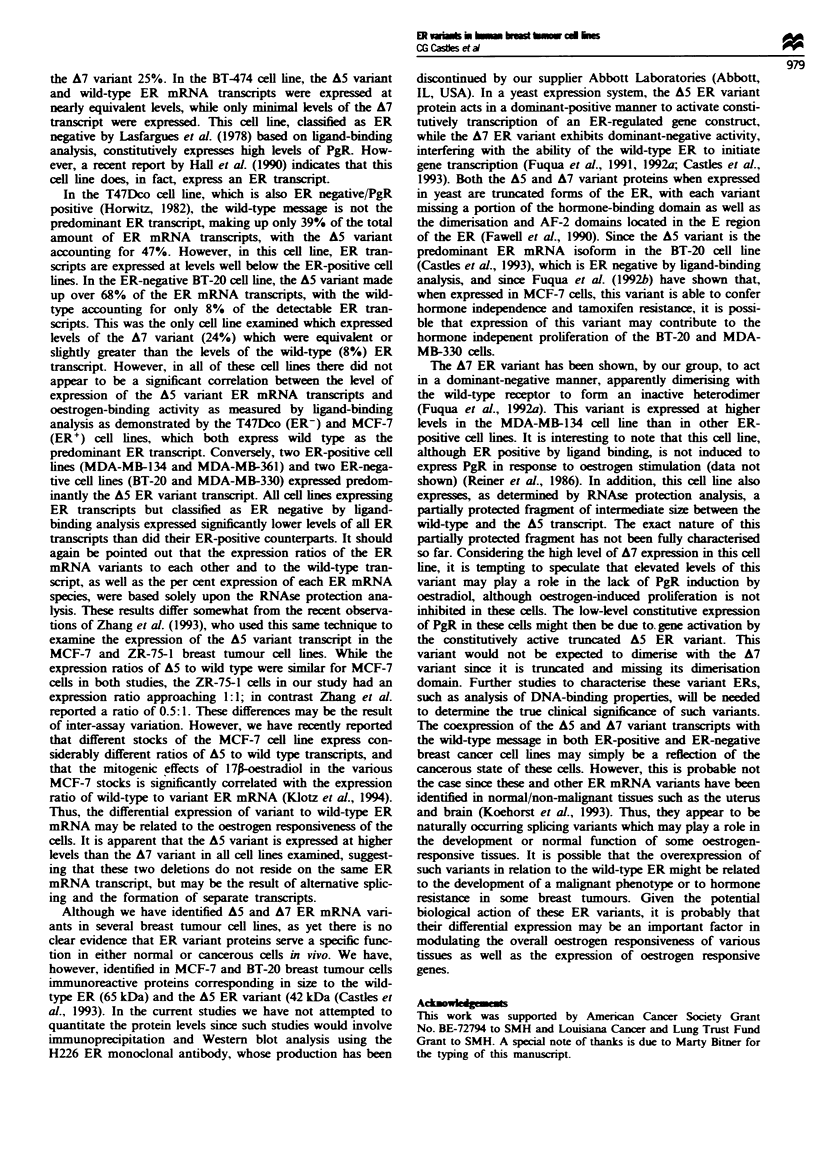
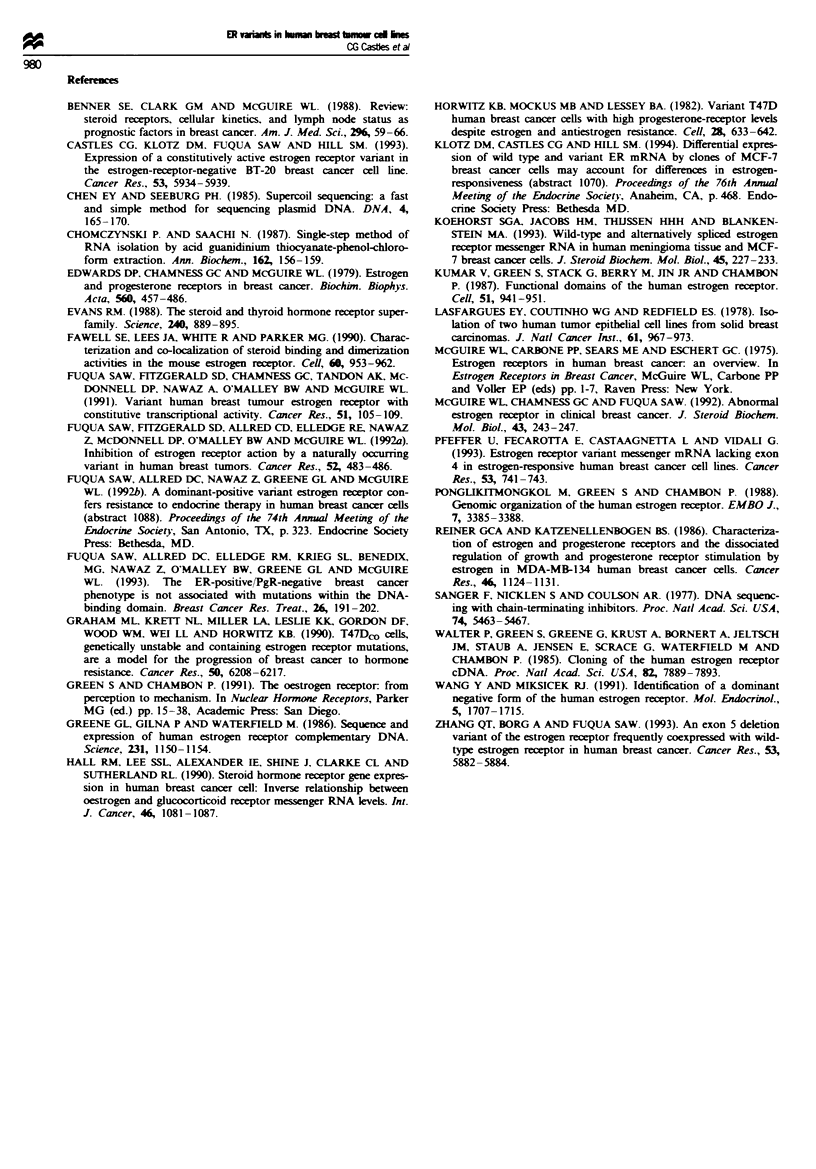
Images in this article
Selected References
These references are in PubMed. This may not be the complete list of references from this article.
- Benner S. E., Clark G. M., McGuire W. L. Steroid receptors, cellular kinetics, and lymph node status as prognostic factors in breast cancer. Am J Med Sci. 1988 Jul;296(1):59–66. doi: 10.1097/00000441-198807000-00011. [DOI] [PubMed] [Google Scholar]
- Castles C. G., Fuqua S. A., Klotz D. M., Hill S. M. Expression of a constitutively active estrogen receptor variant in the estrogen receptor-negative BT-20 human breast cancer cell line. Cancer Res. 1993 Dec 15;53(24):5934–5939. [PubMed] [Google Scholar]
- Chen E. Y., Seeburg P. H. Supercoil sequencing: a fast and simple method for sequencing plasmid DNA. DNA. 1985 Apr;4(2):165–170. doi: 10.1089/dna.1985.4.165. [DOI] [PubMed] [Google Scholar]
- Chomczynski P., Sacchi N. Single-step method of RNA isolation by acid guanidinium thiocyanate-phenol-chloroform extraction. Anal Biochem. 1987 Apr;162(1):156–159. doi: 10.1006/abio.1987.9999. [DOI] [PubMed] [Google Scholar]
- Edwards D. P., Chamness G. C., McGuire W. L. Estrogen and progesterone receptor proteins in breast cancer. Biochim Biophys Acta. 1979 Dec 19;560(4):457–486. doi: 10.1016/0304-419x(79)90013-1. [DOI] [PubMed] [Google Scholar]
- Evans R. M. The steroid and thyroid hormone receptor superfamily. Science. 1988 May 13;240(4854):889–895. doi: 10.1126/science.3283939. [DOI] [PMC free article] [PubMed] [Google Scholar]
- Fawell S. E., Lees J. A., White R., Parker M. G. Characterization and colocalization of steroid binding and dimerization activities in the mouse estrogen receptor. Cell. 1990 Mar 23;60(6):953–962. doi: 10.1016/0092-8674(90)90343-d. [DOI] [PubMed] [Google Scholar]
- Fuqua S. A., Allred D. C., Elledge R. M., Krieg S. L., Benedix M. G., Nawaz Z., O'Malley B. W., Greene G. L., McGuire W. L. The ER-positive/PgR-negative breast cancer phenotype is not associated with mutations within the DNA binding domain. Breast Cancer Res Treat. 1993;26(2):191–202. doi: 10.1007/BF00689692. [DOI] [PubMed] [Google Scholar]
- Fuqua S. A., Fitzgerald S. D., Allred D. C., Elledge R. M., Nawaz Z., McDonnell D. P., O'Malley B. W., Greene G. L., McGuire W. L. Inhibition of estrogen receptor action by a naturally occurring variant in human breast tumors. Cancer Res. 1992 Jan 15;52(2):483–486. [PubMed] [Google Scholar]
- Fuqua S. A., Fitzgerald S. D., Chamness G. C., Tandon A. K., McDonnell D. P., Nawaz Z., O'Malley B. W., McGuire W. L. Variant human breast tumor estrogen receptor with constitutive transcriptional activity. Cancer Res. 1991 Jan 1;51(1):105–109. [PubMed] [Google Scholar]
- Graham M. L., 2nd, Krett N. L., Miller L. A., Leslie K. K., Gordon D. F., Wood W. M., Wei L. L., Horwitz K. B. T47DCO cells, genetically unstable and containing estrogen receptor mutations, are a model for the progression of breast cancers to hormone resistance. Cancer Res. 1990 Oct 1;50(19):6208–6217. [PubMed] [Google Scholar]
- Greene G. L., Gilna P., Waterfield M., Baker A., Hort Y., Shine J. Sequence and expression of human estrogen receptor complementary DNA. Science. 1986 Mar 7;231(4742):1150–1154. doi: 10.1126/science.3753802. [DOI] [PubMed] [Google Scholar]
- Hall R. E., Lee C. S., Alexander I. E., Shine J., Clarke C. L., Sutherland R. L. Steroid hormone receptor gene expression in human breast cancer cells: inverse relationship between oestrogen and glucocorticoid receptor messenger RNA levels. Int J Cancer. 1990 Dec 15;46(6):1081–1087. doi: 10.1002/ijc.2910460622. [DOI] [PubMed] [Google Scholar]
- Horwitz K. B., Mockus M. B., Lessey B. A. Variant T47D human breast cancer cells with high progesterone-receptor levels despite estrogen and antiestrogen resistance. Cell. 1982 Mar;28(3):633–642. doi: 10.1016/0092-8674(82)90218-5. [DOI] [PubMed] [Google Scholar]
- Koehorst S. G., Jacobs H. M., Thijssen J. H., Blankenstein M. A. Wild type and alternatively spliced estrogen receptor messenger RNA in human meningioma tissue and MCF7 breast cancer cells. J Steroid Biochem Mol Biol. 1993 Apr;45(4):227–233. doi: 10.1016/0960-0760(93)90336-u. [DOI] [PubMed] [Google Scholar]
- Kumar V., Green S., Stack G., Berry M., Jin J. R., Chambon P. Functional domains of the human estrogen receptor. Cell. 1987 Dec 24;51(6):941–951. doi: 10.1016/0092-8674(87)90581-2. [DOI] [PubMed] [Google Scholar]
- Lasfargues E. Y., Coutinho W. G., Redfield E. S. Isolation of two human tumor epithelial cell lines from solid breast carcinomas. J Natl Cancer Inst. 1978 Oct;61(4):967–978. [PubMed] [Google Scholar]
- McGuire W. L., Chamness G. C., Fuqua S. A. Abnormal estrogen receptor in clinical breast cancer. J Steroid Biochem Mol Biol. 1992 Sep;43(1-3):243–247. doi: 10.1016/0960-0760(92)90214-4. [DOI] [PubMed] [Google Scholar]
- Pfeffer U., Fecarotta E., Castagnetta L., Vidali G. Estrogen receptor variant messenger RNA lacking exon 4 in estrogen-responsive human breast cancer cell lines. Cancer Res. 1993 Feb 15;53(4):741–743. [PubMed] [Google Scholar]
- Ponglikitmongkol M., Green S., Chambon P. Genomic organization of the human oestrogen receptor gene. EMBO J. 1988 Nov;7(11):3385–3388. doi: 10.1002/j.1460-2075.1988.tb03211.x. [DOI] [PMC free article] [PubMed] [Google Scholar]
- Reiner G. C., Katzenellenbogen B. S. Characterization of estrogen and progesterone receptors and the dissociated regulation of growth and progesterone receptor stimulation by estrogen in MDA-MB-134 human breast cancer cells. Cancer Res. 1986 Mar;46(3):1124–1131. [PubMed] [Google Scholar]
- Sanger F., Nicklen S., Coulson A. R. DNA sequencing with chain-terminating inhibitors. Proc Natl Acad Sci U S A. 1977 Dec;74(12):5463–5467. doi: 10.1073/pnas.74.12.5463. [DOI] [PMC free article] [PubMed] [Google Scholar]
- Walter P., Green S., Greene G., Krust A., Bornert J. M., Jeltsch J. M., Staub A., Jensen E., Scrace G., Waterfield M. Cloning of the human estrogen receptor cDNA. Proc Natl Acad Sci U S A. 1985 Dec;82(23):7889–7893. doi: 10.1073/pnas.82.23.7889. [DOI] [PMC free article] [PubMed] [Google Scholar]
- Wang Y., Miksicek R. J. Identification of a dominant negative form of the human estrogen receptor. Mol Endocrinol. 1991 Nov;5(11):1707–1715. doi: 10.1210/mend-5-11-1707. [DOI] [PubMed] [Google Scholar]
- Zhang Q. X., Borg A., Fuqua S. A. An exon 5 deletion variant of the estrogen receptor frequently coexpressed with wild-type estrogen receptor in human breast cancer. Cancer Res. 1993 Dec 15;53(24):5882–5884. [PubMed] [Google Scholar]





